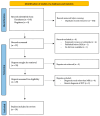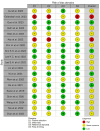Artificial Intelligence in Rotator Cuff Tear Detection: A Systematic Review of MRI-Based Models
- PMID: 40506887
- PMCID: PMC12154083
- DOI: 10.3390/diagnostics15111315
Artificial Intelligence in Rotator Cuff Tear Detection: A Systematic Review of MRI-Based Models
Abstract
Objective: This descriptive systematic review aimed to assess in the available literature on the current application and overall performance of Artificial Intelligence (AI) models in the diagnosis and classification of Rotator Cuff Tears (RCTs) using MRIs. Methods: The systematic review was performed by two of the authors from 2020 to November 2024. Only diagnostic studies involving AI application to MRI images of the rotator cuff were considered, including supraspinatus and biceps tears. Studies evaluating AI applications to Ultrasound or X-ray, or including only healthy rotator cuffs, were not analyzed in this paper. Results: The coronal plane in the T2 sequence emerged as the predominant imaging protocol, with the VGG network being the most widely utilized AI model. The studies included in this research exhibited a solid performance of the AI models with accuracy, ranging from 71.0% to 100%. The statistical analysis revealed no significant differences (p > 0.05) in accuracy, sensitivity, specificity, or precision between AI and human experts across studies that included such comparisons. Conclusions: While AI can significantly improve diagnostic efficiency and workflow optimization, future studies must focus on external validation, regulatory approval, and AI-human collaboration models to ensure safe and effective integration into orthopedic imaging.
Keywords: MRI; artificial intelligence; diagnosis; rotator cuff.
Conflict of interest statement
The authors declare no conflicts of interest.
Figures
References
-
- Hill J.R., Olson J.J., Sefko J.A., Steger-May K., Teefey S.A., Middleton W.D., Keener J.D. Does surgical intervention alter the natural history of degenerative rotator cuff tears? Comparative analysis from a prospective longitudinal study. J. Shoulder Elb. Surg. 2024;34:430–440. doi: 10.1016/j.jse.2024.05.056. - DOI - PMC - PubMed
-
- Redondo-Alonso L., Chamorro-Moriana G., Jiménez-Rejano J.J., López-Tarrida P., Ridao-Fernández C. Relationship between chronic pathologies of the supraspinatus tendon and the long head of the biceps tendon: Systematic review. BMC Musculoskelet. Disord. 2014;15:377. doi: 10.1186/1471-2474-15-377. - DOI - PMC - PubMed
-
- Calvo E., Guardado C.R., Morcillo D., Arce G. Rotator Cuff Across the Life Span. Springer; Berlin/Heidelberg, Germany: 2019. Diagnosis and Classification of Rotator Cuff Tears; pp. 3–10.
-
- Loew M., Magosch P., Lichtenberg S., Habermeyer P., Porschke F. How to discriminate between acute traumatic and chronic degenerative rotator cuff lesions: An analysis of specific criteria on radiography and magnetic resonance imaging. J. Shoulder Elb. Surg. 2015;24:1685–1693. doi: 10.1016/j.jse.2015.06.005. - DOI - PubMed
Publication types
LinkOut - more resources
Full Text Sources



